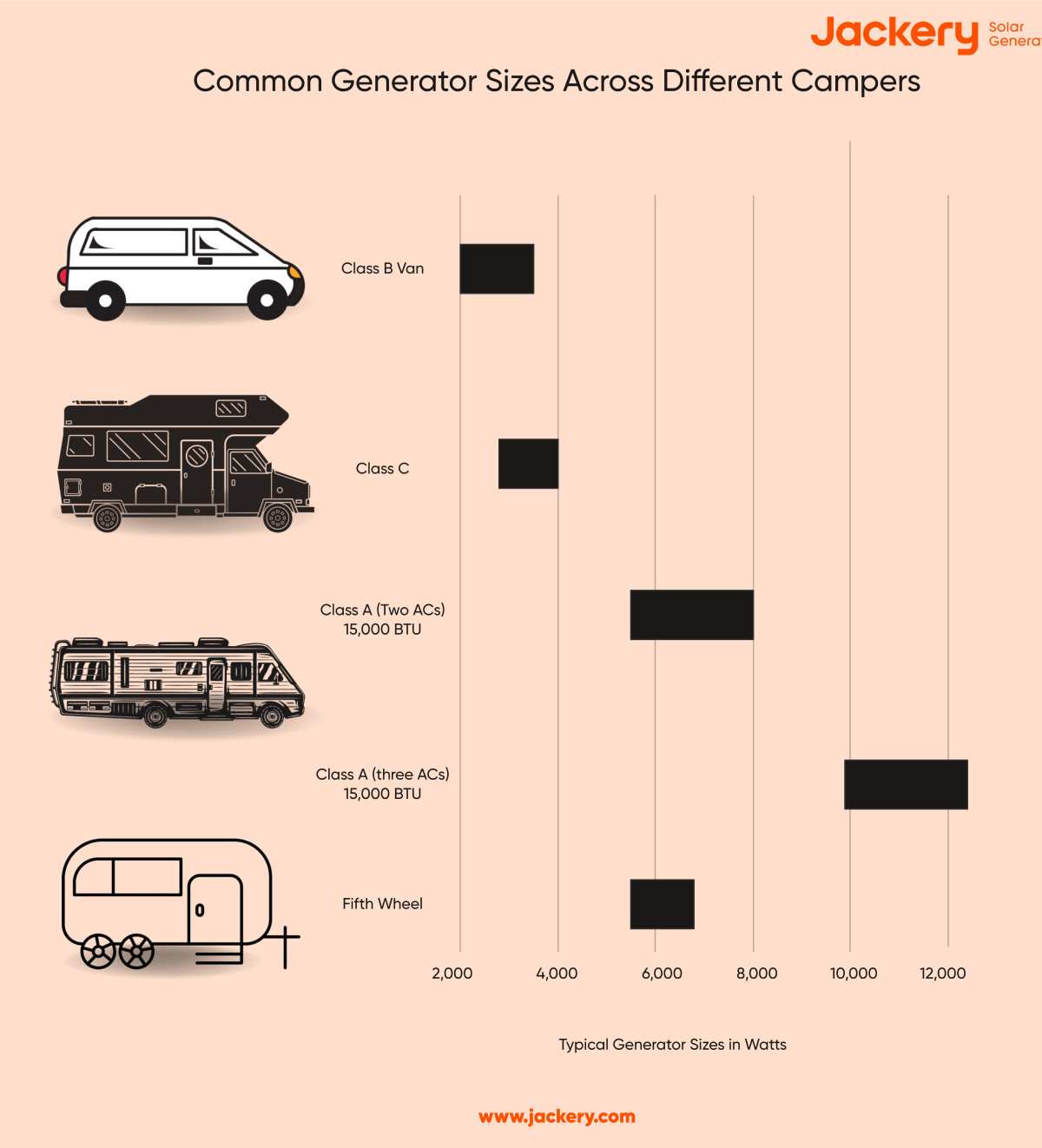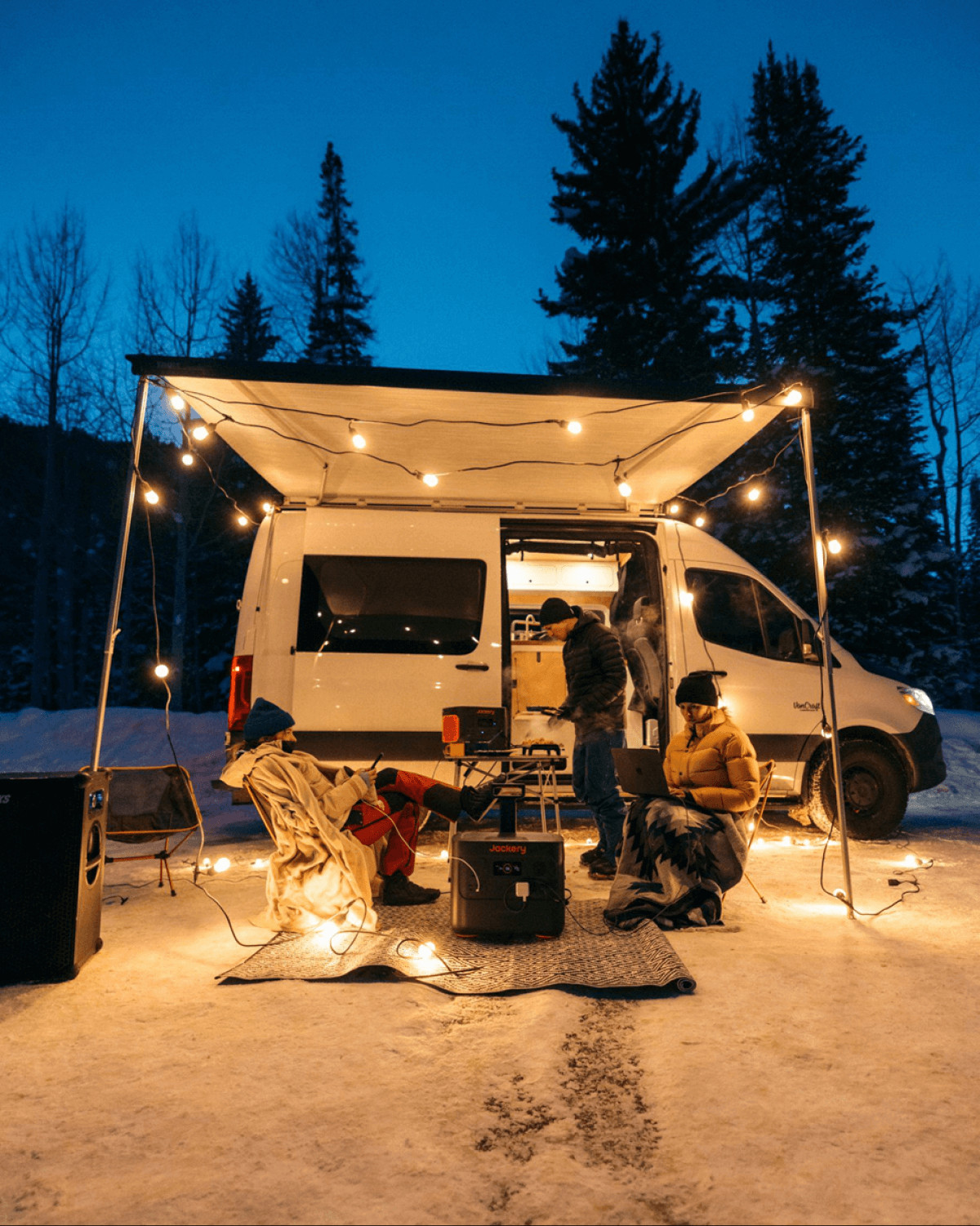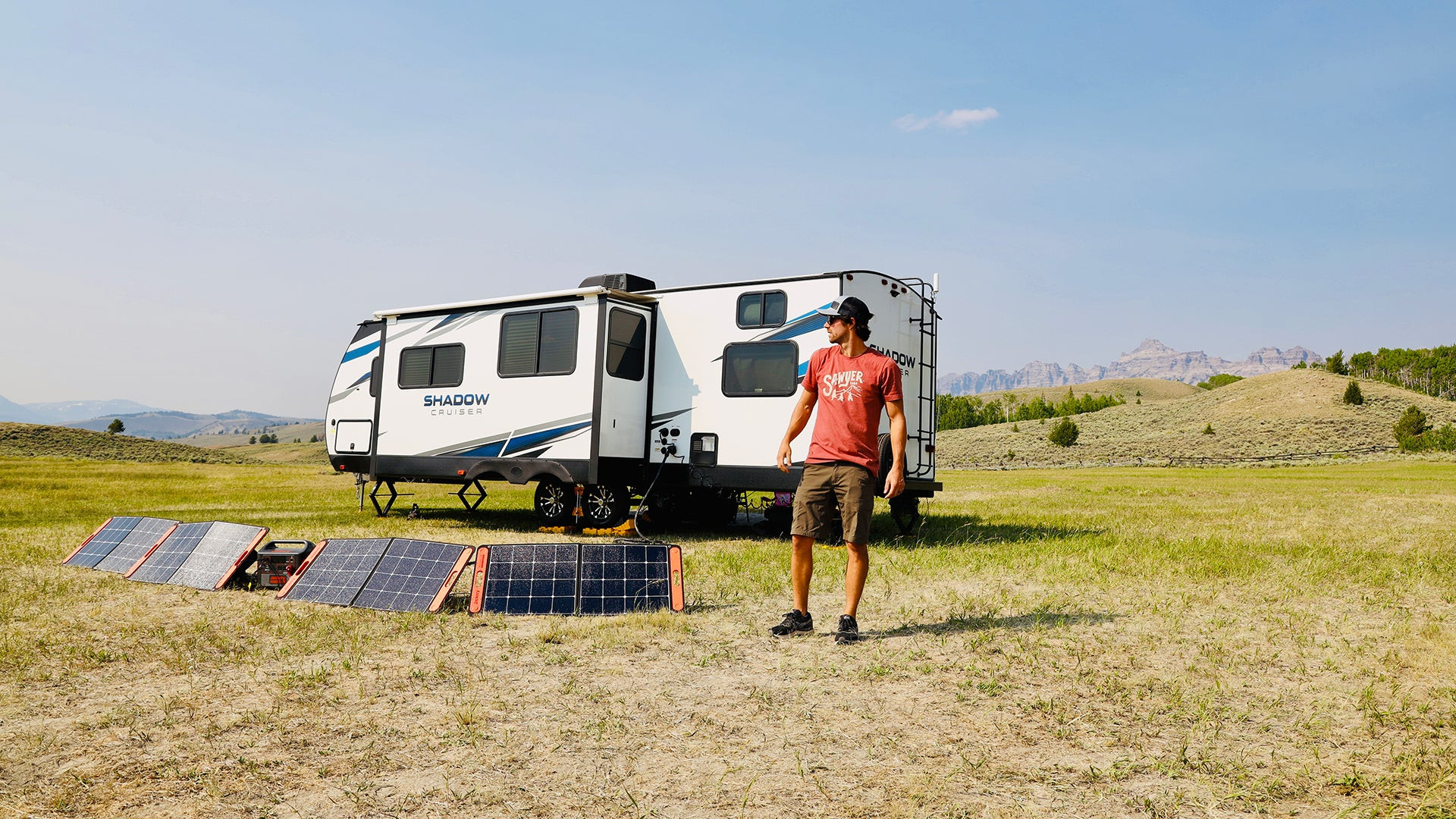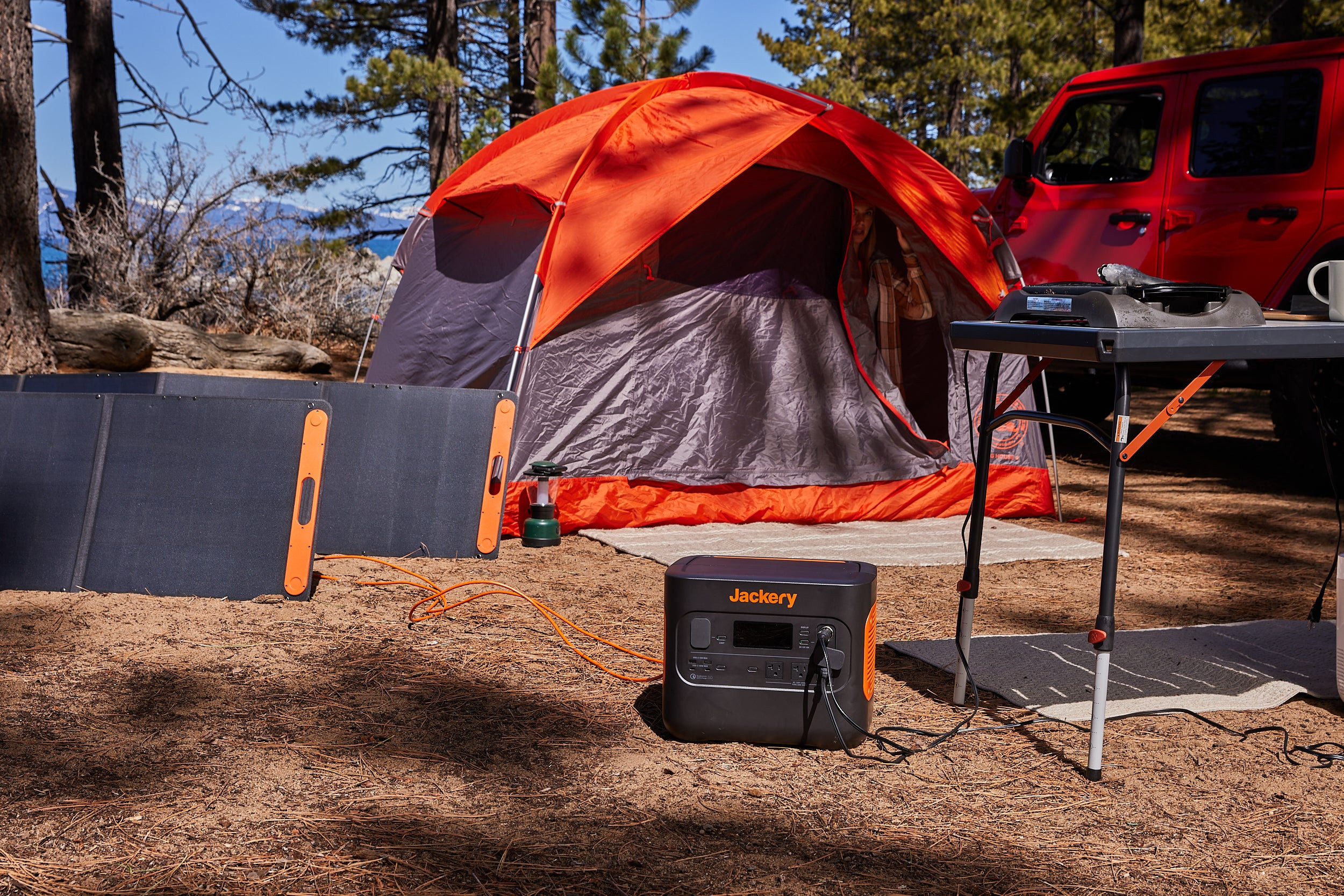Navigating the world of travel trailers and RVs opens up exciting possibilities for exploring destinations like Vietnam with comfort and convenience. A key component for any travel trailer is a reliable power source, and understanding What Size Generator Is Needed For A Travel Trailer is crucial. SIXT.VN, your trusted travel companion, is here to guide you through the process of selecting the perfect generator, ensuring your journey is powered smoothly. This comprehensive guide will cover how to calculate your power needs and introduce you to some excellent options for portable power. Enjoy your trip with suitable power, enhancing your travel experience.
1. Determining the Right Generator Size for Your Travel Trailer
Choosing the correct generator size for your travel trailer involves more than just a quick guess. It requires a careful assessment of your power needs and how you plan to use your appliances. This section breaks down the factors involved and provides practical steps to help you make an informed decision.
1.1. Understanding Your Power Needs: A Step-by-Step Guide
To accurately determine what size generator is needed for a travel trailer, you need to assess the power demands of all appliances and devices you plan to use. This involves two key measurements: running wattage and surge wattage.
- Running Wattage: The continuous power required to keep an appliance running.
- Surge Wattage: The extra power needed for an appliance to start up, typically higher than the running wattage.
-
List Your Appliances: Start by creating a detailed list of all appliances you intend to use in your travel trailer. This might include:
- Air conditioner
- Refrigerator
- Microwave
- Lights
- Television
- Laptop
- Phone charger
- Coffee maker
- Hair dryer
-
Find the Wattage Information: Check the appliance’s label or the manufacturer’s documentation to find both the running wattage and surge wattage. If only amperage is listed, use the formula:
Wattage = Volts x AmpsMost travel trailers in the USA operate on a 120V system.
-
Calculate Total Running Wattage: Add up the running wattage of all the appliances you plan to use simultaneously. This will give you the minimum continuous power you need.
-
Determine Peak Wattage: Identify the appliance with the highest surge wattage. Add this surge wattage to the total running wattage (excluding the running wattage of the appliance with the highest surge). This figure represents the maximum power your generator needs to handle at any given moment.
-
Factor in a Safety Margin: As a general rule, add a 10-20% safety margin to your peak wattage to account for fluctuations and ensure the generator isn’t constantly running at its maximum capacity. This also provides room for adding new devices in the future.
1.2. Case Studies: Generator Sizing for Different Travel Trailer Setups
Let’s consider a few case studies to illustrate how to calculate the appropriate generator size for different travel trailer setups.
1.2.1. Case Study 1: Basic Setup for Weekend Getaways
- Travel Trailer Type: Small travel trailer for weekend trips
- Appliances Used: Lights (100W), refrigerator (200W running, 600W surge), phone charger (20W), small TV (100W)
- Calculations:
- Total Running Wattage: 100W + 200W + 20W + 100W = 420W
- Peak Wattage: 420W (Total Running Wattage) + (600W – 200W) (Refrigerator Surge) = 820W
- Safety Margin (10%): 820W + 82W = 902W
- Recommended Generator Size: A 1000-watt generator would be suitable for this setup, providing enough power for basic needs with a safety margin.
1.2.2. Case Study 2: Family Camping with Comfort
- Travel Trailer Type: Mid-size travel trailer for family camping
- Appliances Used: Lights (150W), refrigerator (200W running, 600W surge), TV (150W), microwave (1000W), air conditioner (1500W running, 2200W surge)
- Calculations:
- Total Running Wattage: 150W + 200W + 150W + 1000W + 1500W = 3000W
- Peak Wattage: 3000W + (2200W – 1500W) (Air Conditioner Surge) = 3700W
- Safety Margin (10%): 3700W + 370W = 4070W
- Recommended Generator Size: A 4000-watt generator would be ideal for this setup, allowing the use of multiple appliances, including the air conditioner, without overloading the system.
1.2.3. Case Study 3: Extended RV Living with All Amenities
- Travel Trailer Type: Large RV for extended living
- Appliances Used: Lights (200W), refrigerator (200W running, 600W surge), two air conditioners (1500W each running, 2200W each surge), TV (200W), microwave (1000W), coffee maker (800W), electric water heater (1200W)
- Calculations:
- Total Running Wattage: 200W + 200W + 3000W + 200W + 1000W + 800W + 1200W = 6600W
- Peak Wattage: 6600W + (2200W – 1500W) (One Air Conditioner Surge) = 7300W
- Safety Margin (10%): 7300W + 730W = 8030W
- Recommended Generator Size: An 8000-watt generator or larger would be necessary for this setup to comfortably handle all the appliances, especially when both air conditioners are running.
1.3. Generator Types: Traditional vs. Solar
When considering what size generator is needed for a travel trailer, it’s also important to weigh the different types of generators available.
1.3.1. Traditional Generators
Traditional generators typically run on gasoline or propane. They are known for their high power output and reliability, making them suitable for running multiple high-wattage appliances simultaneously. However, they also have drawbacks, including:
- Noise: Can be quite loud, which may disturb fellow campers.
- Emissions: Produce exhaust fumes that can be harmful to the environment and require proper ventilation.
- Fuel Costs: Require a continuous supply of fuel, which can add to travel expenses.
- Maintenance: Regular maintenance is needed to keep them running efficiently.
1.3.2. Solar Generators
Solar generators, also known as portable power stations, combine a battery with an inverter and can be charged via solar panels, wall outlets, or even car chargers. They offer several advantages:
- Quiet Operation: Virtually silent, making them ideal for campgrounds.
- Eco-Friendly: Produce no emissions, reducing your carbon footprint.
- Lower Running Costs: Solar energy is free, significantly reducing fuel costs.
- Low Maintenance: Fewer moving parts mean less maintenance.
However, solar generators also have limitations:
- Limited Capacity: May not be able to handle as many high-wattage appliances simultaneously as traditional generators.
- Charging Time: Rely on sunlight, which can be inconsistent depending on weather conditions.
- Initial Cost: Can be more expensive upfront compared to traditional generators.
1.3.3. According to Research
According to research from the U.S. Department of Energy in [2023], solar energy offers a sustainable and cost-effective solution for powering recreational vehicles, reducing reliance on fossil fuels and minimizing environmental impact.
1.4. Amp Considerations: 30-Amp vs. 50-Amp Service
Travel trailers typically come with either a 30-amp or 50-amp electrical service. Understanding the differences is crucial in determining what size generator is needed for a travel trailer.
1.4.1. 30-Amp Service
- Configuration: A 30-amp RV service provides a single 120-volt power source.
- Wattage Calculation: Wattage = Volts x Amps = 120V x 30A = 3600 watts.
- Ideal Generator Size: A generator in the range of 3000 to 4000 watts is generally sufficient for a 30-amp travel trailer.
1.4.2. 50-Amp Service
- Configuration: A 50-amp RV service provides two 120-volt power sources, effectively doubling the available power.
- Wattage Calculation: Wattage = (Volts x Amps) x 2 = (120V x 50A) x 2 = 12,000 watts.
- Ideal Generator Size: A generator with a capacity of 6000 to 8000 watts is typically needed for a 50-amp travel trailer, especially if you plan to run multiple air conditioners or other high-demand appliances.
 30 Amp vs 50 Amp
30 Amp vs 50 Amp
2. Factors Influencing Generator Performance
Several external factors can affect how well your generator performs. Being aware of these can help you plan better and ensure you’re always getting the most out of your generator.
2.1. Environmental Conditions: Temperature, Humidity, and Altitude
Environmental conditions can significantly impact the performance of your generator, whether it’s a traditional gas-powered unit or a solar generator. Understanding these effects can help you optimize your power usage.
2.1.1. Temperature
Extreme temperatures can impact both traditional and solar generators.
- High Temperatures: Overheating can reduce the efficiency of gas generators, requiring more fuel to produce the same amount of power. Solar panels also become less efficient at higher temperatures, reducing their energy conversion rate.
- Low Temperatures: Cold weather can make it harder to start gas generators and reduce the battery capacity of solar generators.
2.1.2. Humidity
High humidity can cause condensation inside gas generators, leading to corrosion and reduced performance. Solar panels are generally unaffected by humidity but may require cleaning more frequently to remove moisture buildup.
2.1.3. Altitude
At higher altitudes, the air is thinner, containing less oxygen. This can cause gas generators to run less efficiently, resulting in reduced power output. Solar panels are not directly affected by altitude, but thinner air can lead to slightly higher solar irradiance, potentially increasing their output.
2.2. Maintenance and Fuel Quality
Proper maintenance and using high-quality fuel are essential for keeping your generator running efficiently and reliably.
2.2.1. Maintenance
Regular maintenance ensures your generator operates at peak performance and extends its lifespan. Key maintenance tasks include:
- Oil Changes: Regularly change the oil in gas generators to keep the engine running smoothly.
- Air Filter Cleaning: Clean or replace the air filter to ensure proper airflow to the engine.
- Spark Plug Inspection: Check and replace spark plugs as needed to maintain efficient combustion.
- Battery Maintenance: Keep the battery of solar generators charged and in good condition.
- Solar Panel Cleaning: Regularly clean solar panels to remove dust and debris that can reduce their efficiency.
2.2.2. Fuel Quality
Using high-quality fuel is crucial for gas generators. Low-quality fuel can lead to:
- Engine Deposits: Build-up of deposits that reduce engine performance.
- Fuel Line Clogs: Clogging of fuel lines and filters.
- Reduced Efficiency: Lower power output and increased fuel consumption.
Always use the recommended fuel type and consider adding a fuel stabilizer to prevent fuel degradation during storage.
2.3. Load Management Strategies
Effective load management can help you maximize the efficiency of your generator and avoid overloading the system.
2.3.1. Prioritize Appliances
Identify essential appliances and prioritize their use. Run high-wattage appliances like air conditioners and microwaves separately to avoid exceeding the generator’s capacity.
2.3.2. Stagger Usage
Avoid running multiple high-wattage appliances simultaneously. Stagger their use to distribute the load on the generator. For example, run the coffee maker before using the microwave, rather than at the same time.
2.3.3. Energy-Efficient Alternatives
Consider using energy-efficient appliances and devices to reduce your overall power consumption. LED lights, for example, use significantly less power than traditional incandescent bulbs.
According to the U.S. Energy Information Administration in [2022], implementing energy-efficient practices can reduce overall energy consumption by up to 30%, thereby lessening the load on your generator.
3. Top Solar Generators for Travel Trailers
If you’re leaning towards a solar generator, several models stand out for their performance, reliability, and suitability for travel trailers.
3.1. Jackery Solar Generator 3000 Pro: The Ultimate Power Solution
The Jackery Solar Generator 3000 Pro is a robust and versatile power solution, boasting a 3024Wh capacity. It’s ideal for larger travel trailers with higher power demands, capable of running multiple appliances simultaneously.
- Capacity: 3024Wh
- Key Features:
- High power output to handle multiple high-wattage appliances.
- Fast solar and wall charging capabilities.
- Lightweight and portable design.
- Advanced safety features.
- Ideal For:
- Large travel trailers with high power needs.
- Extended trips where reliability is crucial.
- Campers who want the convenience of running multiple appliances.
- Benefits for Vietnam Travelers:
- Reliable power for extended stays in remote locations.
- Supports a wide range of appliances, ensuring comfort.
 Jackery Solar Generator 3000 Pro
Jackery Solar Generator 3000 Pro
3.2. Jackery Solar Generator 2000 Plus: Expandable and Efficient
The Jackery Solar Generator 2000 Plus offers an expandable capacity from 2-24kWh, making it a flexible choice for various travel trailer sizes and power needs. It combines efficiency with portability, ensuring you have reliable power wherever you go.
- Capacity: Expandable from 2-24kWh
- Key Features:
- Expandable capacity for growing power needs.
- Fast charging and stable power output.
- Multiple output ports for versatile use.
- User-friendly interface.
- Ideal For:
- Mid-size travel trailers with moderate power needs.
- Campers looking for a balance between power and portability.
- Those who may want to add more capacity in the future.
- Benefits for Vietnam Travelers:
- Adaptable power solution for different travel scenarios.
- Reliable performance for powering essential appliances.
 Jackery Solar Generator 2000 Plus
Jackery Solar Generator 2000 Plus
3.3. Jackery Solar Generator 2000 v2: Compact and Lightweight
The Jackery Solar Generator 2000 v2 is designed for those who prioritize portability without sacrificing power. With a 2kWh capacity, it’s perfect for smaller travel trailers and campers with basic power needs.
- Capacity: 2042Wh
- Key Features:
- Compact and lightweight design.
- Multiple output ports for versatile use.
- Quiet operation.
- Easy to transport and store.
- Ideal For:
- Small travel trailers and pop-up campers.
- Weekend trips and short getaways.
- Campers who need a portable and easy-to-use power solution.
- Benefits for Vietnam Travelers:
- Perfect for exploring Vietnam’s diverse landscapes.
- Lightweight and easy to carry.
 Jackery Solar Generator 2000 Pro
Jackery Solar Generator 2000 Pro
4. Integrating Generator Power with SIXT.VN Services
When planning your trip to Vietnam with SIXT.VN, understanding how to integrate your generator power with our services can enhance your travel experience.
4.1. Planning Your Route Based on Power Needs
When mapping out your travel route, consider the availability of power sources along the way. If you’re relying on a solar generator, plan stops in areas with ample sunlight to maximize charging efficiency. If you’re using a traditional generator, ensure you have access to fuel stations.
4.2. Utilizing SIXT.VN for Optimized Travel
SIXT.VN offers a range of services that can help you optimize your travel plans, ensuring you have the power you need:
- Route Planning: Our route planning service can help you identify suitable campsites with power hookups or locations with ample sunlight.
- Accommodation Booking: We can assist you in booking accommodations with reliable power sources, reducing your reliance on generator power.
- Transportation: If you prefer not to carry a generator, consider using our transportation services to access locations with existing power infrastructure.
Address: 260 Cau Giay, Hanoi, Vietnam.
Hotline/Whatsapp: +84 986 244 358
Website: SIXT.VN
4.3. Enhancing Your Vietnam Travel Experience
By integrating your generator power with SIXT.VN services, you can enjoy a seamless and enhanced travel experience in Vietnam. Whether you’re exploring the bustling streets of Hanoi or the serene landscapes of Ha Long Bay, having a reliable power source ensures you can stay connected, comfortable, and powered up throughout your journey.
5. Troubleshooting Common Generator Issues
Even with the best planning, you might encounter issues with your generator. Knowing how to troubleshoot common problems can save you time and frustration.
5.1. Starting Problems
- Gas Generators:
- Issue: Engine won’t start.
- Troubleshooting Steps:
- Check fuel level and add fuel if necessary.
- Ensure the fuel valve is open.
- Inspect the spark plug for damage or fouling.
- Clean or replace the air filter.
- Check the battery (if equipped with electric start).
- Solar Generators:
- Issue: Won’t turn on or charge.
- Troubleshooting Steps:
- Ensure the battery is not completely depleted.
- Check the connections to the solar panels or wall outlet.
- Inspect the charging cables for damage.
- Verify the solar panels are receiving direct sunlight.
5.2. Overload and Shutdown
- Gas Generators:
- Issue: Generator shuts down due to overload.
- Troubleshooting Steps:
- Disconnect all appliances.
- Restart the generator.
- Reconnect appliances one at a time to identify the overload source.
- Avoid using multiple high-wattage appliances simultaneously.
- Solar Generators:
- Issue: Shuts down due to exceeding capacity.
- Troubleshooting Steps:
- Disconnect appliances to reduce the load.
- Check the generator’s display for error messages.
- Consult the user manual for recommended solutions.
5.3. Reduced Power Output
- Gas Generators:
- Issue: Lower power output than expected.
- Troubleshooting Steps:
- Check the air filter for clogs.
- Inspect the spark plug.
- Ensure the engine is properly tuned.
- Check fuel lines for obstructions.
- Solar Generators:
- Issue: Lower power output from solar panels.
- Troubleshooting Steps:
- Ensure the solar panels are clean and free from obstructions.
- Check the angle and orientation of the solar panels for optimal sunlight exposure.
- Inspect the connections between the solar panels and the generator.
- Verify the solar panels are not damaged.
6. Essential Safety Tips for Generator Use
Safety should always be a top priority when using a generator. Here are some essential safety tips to keep in mind:
- Ventilation: Always operate gas generators in well-ventilated areas to prevent carbon monoxide poisoning.
- Carbon Monoxide Detectors: Install carbon monoxide detectors in your travel trailer and check them regularly.
- Fuel Storage: Store fuel safely in approved containers and away from the generator.
- Electrical Safety: Use appropriately sized extension cords and avoid overloading circuits.
- Water and Moisture: Never operate a generator in wet conditions or allow it to get wet.
- Maintenance: Regularly inspect and maintain your generator to ensure it’s in good working condition.
- Professional Help: If you encounter any issues you can’t resolve, seek professional help from a qualified technician.
7. Understanding Travel Trailer Electrical Systems
Gaining a deeper understanding of travel trailer electrical systems will greatly assist in selecting the right generator and using it efficiently.
7.1. 12V DC System
- Function: Powers lights, water pump, and other small appliances.
- Power Source: Primarily supplied by the travel trailer’s battery, which is charged by the tow vehicle or an onboard converter.
- Generator Role: The generator can power the converter to charge the battery, providing a backup power source.
7.2. 120V AC System
- Function: Powers larger appliances like air conditioners, microwaves, and televisions.
- Power Source: Supplied by shore power (external electrical hookup) or a generator.
- Generator Role: Provides the necessary AC power when shore power is unavailable.
7.3. Power Converter and Inverter
- Power Converter: Converts 120V AC power from shore power or a generator to 12V DC power to charge the battery and run 12V appliances.
- Inverter: Converts 12V DC power from the battery to 120V AC power to run certain appliances when shore power or a generator is not available.
Understanding how these systems work together can help you make informed decisions about what size generator is needed for a travel trailer and how to manage your power usage effectively.
8. Future Trends in Travel Trailer Power Solutions
The world of travel trailer power solutions is constantly evolving. Staying informed about emerging trends can help you make smart choices for your current and future travel needs.
8.1. Advancements in Solar Technology
- More Efficient Panels: Solar panel technology is continually improving, resulting in higher energy conversion rates and increased power output from smaller panels.
- Flexible Solar Panels: These panels can be mounted on curved surfaces, maximizing the available surface area for solar energy capture.
- Improved Battery Technology: Lithium-ion batteries are becoming more affordable and offer higher energy density, longer lifespans, and faster charging times.
8.2. Smart Generator Features
- Remote Monitoring: Generators with remote monitoring capabilities allow you to track power usage, fuel levels, and maintenance needs from your smartphone or tablet.
- Automatic Start/Stop: These features automatically start the generator when the battery is low and shut it off when it’s fully charged, conserving fuel and reducing noise.
- Hybrid Solutions: Combining traditional generators with solar power and battery storage systems offers a balanced approach, providing reliable power while minimizing environmental impact.
8.3. Integration with Smart Home Systems
- Smart Power Management: Integrating your travel trailer’s power system with smart home technology allows for automated power management, optimizing energy usage and reducing waste.
- Voice Control: Control your generator and other appliances with voice commands, adding convenience and ease of use.
By staying informed about these trends, you can make informed decisions about what size generator is needed for a travel trailer and how to optimize your power solutions for a more sustainable and enjoyable travel experience.
9. FAQs About Travel Trailer Generators
9.1. Will a 3000-watt Generator Run a Pop-Up Camper?
Yes, a 3,000-watt generator is generally sufficient for a pop-up camper. It can power essential appliances such as a microwave, lights, and a small refrigerator.
9.2. How Many Watts Does It Take to Run an AC in a Camper?
The average camper air conditioner requires between 600 and 1,700 watts per hour, with startup costs ranging from 1,900 to 3,500 watts.
9.3. Can You Run a Camper Generator While Sleeping?
Yes, you can run a solar generator while sleeping, but ensure you follow all safety precautions. However, running diesel or fossil fuel generators can be dangerous and noisy.
9.4. What Size Generator Do I Need for a 30 Ft Camper?
A 3,000 to 3,500-watt generator is ideal for most 30-amp campers. This size can run a small RV AC, lights, and other appliances like refrigerators and microwave ovens.
9.5. What Size Generator Do I Need for a 30-Amp RV Air Conditioner?
A 2,500 to 2,800-watt generator is often a good minimum threshold for 30-amp RVs with an AC unit.
9.6. How Much Does A Generator Cost?
According to Home Depot, the average generator costs between $450 to $1200
10. Final Thoughts
Determining what size generator is needed for a travel trailer involves understanding your power needs, considering the type of generator, and factoring in environmental conditions and maintenance. Whether you opt for a traditional gas generator or a modern solar generator, the right power solution can significantly enhance your travel experience.
With SIXT.VN, you can plan your journey to Vietnam with confidence, knowing you have the power you need to explore the country’s stunning landscapes and vibrant culture. From route planning to accommodation booking, SIXT.VN is your trusted partner for unforgettable travel experiences.



